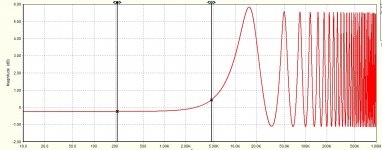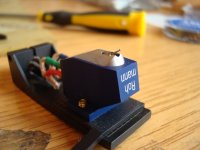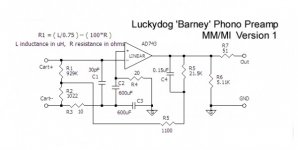Basically we are looking for any evidence of roll off greater than second order at the high end that might be due to something other than the LCR response of cart and phono stage. Just looking around for any internet evidence as there are a lot of measurements of this cart around. First port of call is here.
Load the Magnets!!! - [English]
Now his premise that the actual FR must be due to mech resonance falls down when you see he is using the 'text book generator model'. Looking at his measured FR it does seem to fall off a cliff, but he is sampling at 44.1kHz, so that is to be expected. Phooey no use.
Next up https://sites.google.com/site/zevaudio/turt/cartridge-comparison-list/shure-1000e. not this is an M97 SAS stylus on a 1000e body. Now in this case the does appear to be a steep roll off , but as nothing posted on the test methodology could be 44.1kHz sampling rather than the claimed mech resonance.
How you measure this is the big question, at least for those of us mortals without the $$$ B&K test records. Maybe LD's idea of finding a disposable album and putting a scratch on it might work.
What is for sure is that people have been blaming certain things on mechanical resonances since the 70s but not sure any of them actually checked (other than those clever guys in white coats at B&K).
I started re-reading this earlier https://www.vinylengine.com/turntable_forum/viewtopic.php?f=19&t=33929 .. A useful adjunct as it covers a lot of the same ground, but at 500 posts is quite long.
Load the Magnets!!! - [English]
Now his premise that the actual FR must be due to mech resonance falls down when you see he is using the 'text book generator model'. Looking at his measured FR it does seem to fall off a cliff, but he is sampling at 44.1kHz, so that is to be expected. Phooey no use.
Next up https://sites.google.com/site/zevaudio/turt/cartridge-comparison-list/shure-1000e. not this is an M97 SAS stylus on a 1000e body. Now in this case the does appear to be a steep roll off , but as nothing posted on the test methodology could be 44.1kHz sampling rather than the claimed mech resonance.
How you measure this is the big question, at least for those of us mortals without the $$$ B&K test records. Maybe LD's idea of finding a disposable album and putting a scratch on it might work.
What is for sure is that people have been blaming certain things on mechanical resonances since the 70s but not sure any of them actually checked (other than those clever guys in white coats at B&K).
I started re-reading this earlier https://www.vinylengine.com/turntable_forum/viewtopic.php?f=19&t=33929 .. A useful adjunct as it covers a lot of the same ground, but at 500 posts is quite long.
And not due to generator's natural roll-off, badly implemented RIAA which keeps rolling, cut-off on the test record etc etc.Basically we are looking for any evidence of roll off greater than second order at the high end that might be due to something other than the LCR response of cart and phono stage.
Unfortunately many things can mimic a steep monotonic roll-off over the limited frequency range of interest. More positively, I think what one is looking for as a signature is a sign of 2nd resonant peak that arises naturally in the TL model, but not the spring-mass model.
Here's a rough plot of TL resonant series, with no losses, a sort of spherical cow as to what the signature should resemble. Hope this makes sense. You can see that within this series there exists steep 'roll-offs' if one examines only a limited f range, say just above the 1st resonance.
It's probably such resemblance that might have supported historic lack of inquisitiveness as to what doesn't fit, especially at ultrasonic frequencies, and especially as to the 2nd or 3rd peak/inflections, IMO.
IIRC, mechanical response was obtained by subtracting observed response from theoretical LCR response, which IMO is a good start, and probably indicates correctly the mechanical resonant frequency, well the 1st in the series anyway. Many other factors complicate the ultrasound response, as above, and the cut-off could be anything I think. But perhaps the best about ? I suppose I would say that......Next up https://sites.google.com/site/zevaudio/turt/cartridge-comparison-list/shure-1000e. not this is an M97 SAS stylus on a 1000e body. Now in this case the does appear to be a steep roll off , but as nothing posted on the test methodology could be 44.1kHz sampling rather than the claimed mech resonance.
LD
Attachments
For clarity, I don't mean that this Shure cart, nor the stytlus variants, is the best there is ! I mean that Zevaudio's approach to analysing mechanical resonance is the best I am aware of, warts and all.Only concern is the SAS is boron rod with an ultralight Namiki microridge, same as AT use. How (or why) did Jico end up with this. Doesn't bode well for the sapphire version which is a shame.
On the face of it, this cart/stylus, as presented there, has a resonant f in the audioband. For reasons discussed previously, this may not be uncommon, but I think it's better for the resonance to be above the audioband and clear of programme content.
Perhaps the move to boron was associated with moving resonant f out of the audioband, but presumably the original had a design intention associated with placement in the audioband, if the face value measurement is right ? Perhaps to prop up generator hf response, that seems common enough?
I wonder how much is design and how much is empirical, in general.
LD
Thanks, Bill.Found the paper http://www.theanalogdept.com/images/spp6_pics/TT_Design/MechanicalResonances.pdf . Page 10 discusses sawing a record to get a 0.2mm step.
It must have been fun working at B&K in the 70s!
Strange this paper is silent about the top resonance, since it covers the others fairly comprehensively.
The lf cart-arm resonance is well treated there IMO. The most important matter of settle time, is considered there. Not often considered, but that is the key to lf stability in my book. Note how long it takes the arm to recover from a displacement event, and during this time pitch varies and trackability is compromised.
I wonder why the top mechanical resonance (hf) was seldom discussed back in the day ?
LD
My undertanding of the zev test was a JICO boron SAS on the 1000e, so an aftermarket stylus intended for the M97 on an older body. I forgot to note that the boron rod JICO use is a hoofing great thing next to the whisker that AT use, but from the data presented if the resonance is there in the stylus, then either
1. The M97 needs the prop up
2. JICO just shove the same assembly in everything.
If 2 is the case then we need to look at the original SAS design, which was done for their own cartridge which was a generic japanese cartrige as used by A&R, Garrot, Sumiko. shelter etc. Oddly I have one of those (not with SAS) mounted on my Kenwood so when* I get that working again will have a look.
As for them not looking at high resonances I have always assumed that they were using ultra high compliance carts that were in vogue from the quadrophonic era so it just wasn't an issue? Or the VST series.
*For a given value of when. I have 16 weeks after which projects will be on hold for 6 months or more again.
1. The M97 needs the prop up
2. JICO just shove the same assembly in everything.
If 2 is the case then we need to look at the original SAS design, which was done for their own cartridge which was a generic japanese cartrige as used by A&R, Garrot, Sumiko. shelter etc. Oddly I have one of those (not with SAS) mounted on my Kenwood so when* I get that working again will have a look.
As for them not looking at high resonances I have always assumed that they were using ultra high compliance carts that were in vogue from the quadrophonic era so it just wasn't an issue? Or the VST series.
*For a given value of when. I have 16 weeks after which projects will be on hold for 6 months or more again.
OK lucky GB and USA guys,
I am a bit lucky too to understanding Dutch a bit
but I could not understand from the text what should be R1 resistance to get right electronic damping at the input and right falling the correction curve...
Do you know the formula?
R1=4500*Lcart
With Lcart is 600mH, R1 becomes 2700 Ohm.
Thank you!
fpr AT440MLa with Lcart=490mH
R1 should be 4500*490mH=2205 Ohm = 2k2
is this correct?
Yes, assuming a 100pf cable capacity from TT to preamp.
OK, yes seems that measurement is for the Jico/SAS. Wouldn't surprise me, but can't remember, if that generator needed a leg up at hf.My undertanding of the zev test was a JICO boron SAS on the 1000e, so an aftermarket stylus intended for the M97 on an older body. I forgot to note that the boron rod JICO use is a hoofing great thing next to the whisker that AT use, but from the data presented if the resonance is there in the stylus, then either
1. The M97 needs the prop up
2. JICO just shove the same assembly in everything.
I came to realise that cantilever design can be counterintuitive, and the perception that all that matters is mass can be misleading. Rods are not a good use of mass, that seems sure. But otherwise, 'thumpers' in the sense of fat cantilevers can be perfectly good, even if there is a perception issue perhaps.
They being B&K.... puzzling because the quad era is when ultrasound performance became a matter of public interest and differentiation. The top-resonance is definitely south of the cartridge suspension, which doesn't participate. The perceived need for low VTF to avoid quad wear might well have been a factor in driving compliance to very high figures? Not related to the top resonance though........As for them not looking at high resonances I have always assumed that they were using ultra high compliance carts that were in vogue from the quadrophonic era so it just wasn't an issue? Or the VST series.
Seize the day !I have 16 weeks after which projects will be on hold for 6 months or more again.
LD
Last edited:
Or as Red Green used to say 'Carpe Ductum'
(in case the Red Green show hasn't made it to the big city Watch - Red Green ).
(in case the Red Green show hasn't made it to the big city Watch - Red Green ).
On the cantilever front, I picked one of these up for £90 as the needle has been ripped out and the cantilever is slightly twisted. It's on hold for the time being until I have the money for re-tipping, but I hope the twist can be twisted out as it is the nicest looking tapered thinwall Al construction I have personally seen.
(OT: For when not playing with MMs it also ticks all the audiophile boxes
1.fancy construction for no real gain with Carbon fibre armature and silver coils
2. Machined from solid body
3. stupidly low output meaning I have to build a new phono stage just for it.
4. I wanted an MC-2000 but they go for too much even used. )
(OT: For when not playing with MMs it also ticks all the audiophile boxes
1.fancy construction for no real gain with Carbon fibre armature and silver coils
2. Machined from solid body
3. stupidly low output meaning I have to build a new phono stage just for it.
4. I wanted an MC-2000 but they go for too much even used. )
Attachments
In order to keep some links together It was just pointed out to me that one of the earliest references to a damped loading was the Barney Oliver amp of 1973 http://www.hparchive.com/Manuals/Barney_Oliver_Amplifier_Manual.pdf
I also found this blast from the past. With a few tweeks would be a good candidate for a flat pre to 2kHz. LD is like the easter bunny hiding this stuff around the web
I also found this blast from the past. With a few tweeks would be a good candidate for a flat pre to 2kHz. LD is like the easter bunny hiding this stuff around the web
Attachments
In order to keep some links together It was just pointed out to me that one of the earliest references to a damped loading was the Barney Oliver amp of 1973 http://www.hparchive.com/Manuals/Barney_Oliver_Amplifier_Manual.pdf
I also found this blast from the past. With a few tweeks would be a good candidate for a flat pre to 2kHz. LD is like the easter bunny hiding this stuff around the web
AD743, warms my heart that boy.
No one has asked about the current avatar, it would have been seen around Ridgewell UK circa 1944 my father's B17 squadron patch (the best of the lot IMHO).
Last edited:
Is that another Scott Special(tm)?
Of course.
No one has asked about the current avatar, it would have been seen around Ridgewell UK circa 1944 my father's B17 squadron patch (the best of the lot IMHO).
Well as you had already discussed that on the blowtorch thread with Dick I just interpolated...
Well as you had already discussed that on the blowtorch thread with Dick I just interpolated...
Sorry slipped my mind. I just pulled out my copy of DAFOS and there is a side 1 label on both sides, is this it, a unique rarity?
- Home
- Source & Line
- Analogue Source
- mechanical resonance in MMs


